How to Change a Tire on a Car
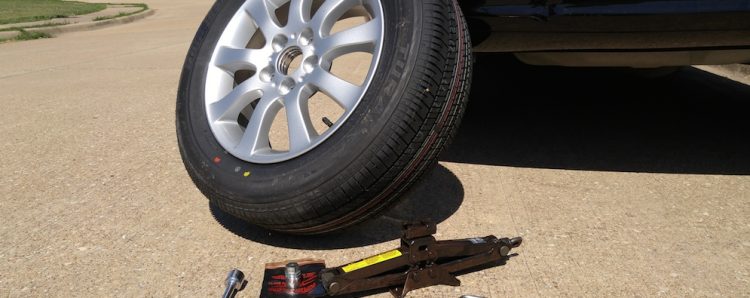
One of the many great things about being a man is having know-how and initiative, right? You’re damn right. As the years have passed, many men have started knowing how to do less things. The notion of being “handy” occasionally feels like it belongs on the endangered species list.
Not on my watch. I have built engines, torn apart suspensions, MacGyver’d systems to fix the unfixable, and more, and I’m not about to let us all continue this mechanical decline without a fight. Many of the basic skills every man should know can be taught in one sitting, like how to change your oil, replace wiper blades, bulbs, belts, brakes, and of course, change a tire on a car. Even if a man never needs to do these things, he should still know how. Because one day, mark my words, he will need these skills in some capacity.
Here’s my step-by-step guide on how to change a tire on a car.
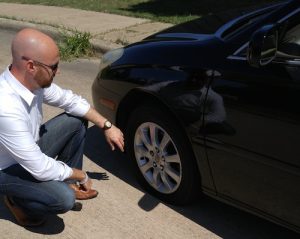 First thing’s first: most cars do not have a full-size spare, and instead have a “donut” in the trunk. The process is still the same. When running on a donut, you want to get the tire fixed and replace the spare with the new tire right away. Do NOT drive on your little spare for more than a day. It’s meant to get you to the shop to get your tire fixed, not give you a new wheel to drive around on until you find the time to fix the flat. Don’t be that guy.
First thing’s first: most cars do not have a full-size spare, and instead have a “donut” in the trunk. The process is still the same. When running on a donut, you want to get the tire fixed and replace the spare with the new tire right away. Do NOT drive on your little spare for more than a day. It’s meant to get you to the shop to get your tire fixed, not give you a new wheel to drive around on until you find the time to fix the flat. Don’t be that guy.
When you discover you’ve got a flat tire, get to the side of the road, a parking lot, or pull off into a neighborhood (like I did) and make sure you’ve got some room to work. If you happen to be on an expressway, try to pull over onto the shoulder as far as possible, or find space near exit ramps (occasionally there is extra pavement there for you to pull onto).
1. Apply the emergency brake
This should go without saying, but let’s err on the side of caution, shall we? If yours happens to not work, find a way to chock the wheels so the car doesn’t roll when you use the jack.
2. Remove your jack and tools from the trunk
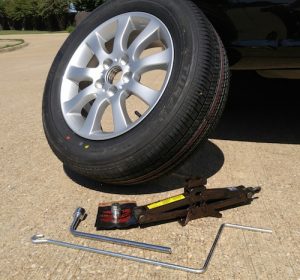
This will include your spare tire, your jack, your tire iron, and many cars include a crank/rod to hook into the end of the jack so you can simply “crank” the jack into the correct position. If not, you can use a screwdriver as a handle by inserting it into the hole at the rotating adjustment piece of the jack. Your car may also need a wheel key, which will normally be in the trunk with the rest of the tools, or occasionally in the glovebox. (see image)
3. Loosen your lug nuts
(DO NOT REMOVE THEM)
This is important! While the car is on the ground, with the emergency brake applied, you want to use the tire iron to loosen the lug nuts ONLY until they give. As soon as they go from, “holy crap, these are really on there” to “I think I can turn them with the iron and a little bit of effort” you want to stop. You want them to remain on the wheel, but not so tight that you can’t loosen them without rotating the wheel or rocking the car – hence, why we break them loose while the car is on the ground.
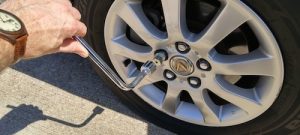
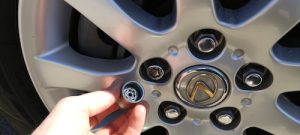
4. Place jack in position and crank it up
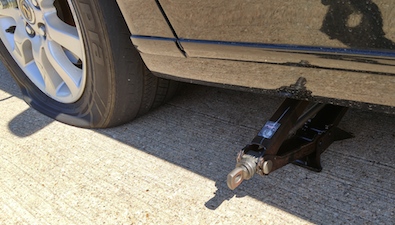 About 6-8″ from the wheel well, there will be a “jacking point” on the underside of the car. If you get on your hands and knees and take a look, you’ll see one near all four wheels. Place the jack under it so when you begin to crank the jack up, it will grab the correct spot and your car will lift safely. You’ll know you’re high enough when the tire is completely off the ground. If completely flat, make sure it’s off the ground by at least an inch to accommodate for the new, inflated spare.
About 6-8″ from the wheel well, there will be a “jacking point” on the underside of the car. If you get on your hands and knees and take a look, you’ll see one near all four wheels. Place the jack under it so when you begin to crank the jack up, it will grab the correct spot and your car will lift safely. You’ll know you’re high enough when the tire is completely off the ground. If completely flat, make sure it’s off the ground by at least an inch to accommodate for the new, inflated spare.
5. Remove all the lug nuts and the wheel
Now that the tire is off the ground, use the tire iron or your hand to remove all the lug nuts, place them to the side, and remove the flat wheel. Place it off to the side/front/rear/out of the way, and roll the spare up into position. You’re past halfway, Stud! You basically know how to change a tire on a car now! Wait, there’s more…
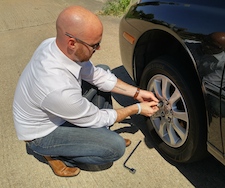
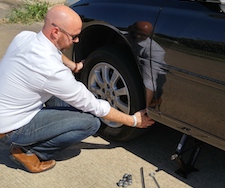
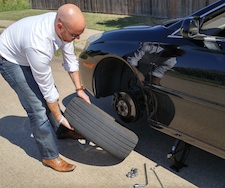
6. Place the spare on the wheel studs and secure with lug nuts
You’ll have to lift the spare slightly to get it into position so the tire can rest on the wheel studs. If you happen to have a German car that has lug bolts instead, align the wheel on the hub and replace the bolts you removed in step 5. Patience is the key to your success with lug bolts. Regardless of which you have on your car, tighten them down in a STAR pattern. You may have to shimmy the wheel a little to make sure it is flat against the rotor/hub. Tighten the lug nuts down as much as you can without rocking the car or rotating the wheel.
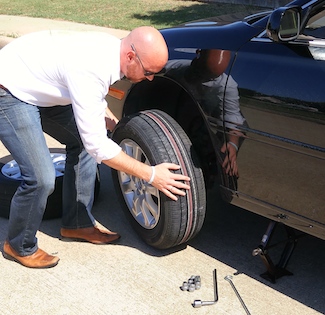
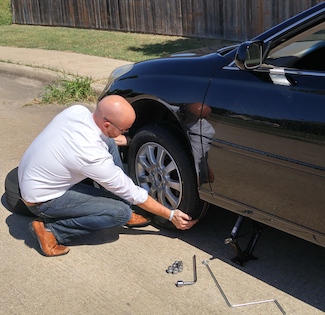
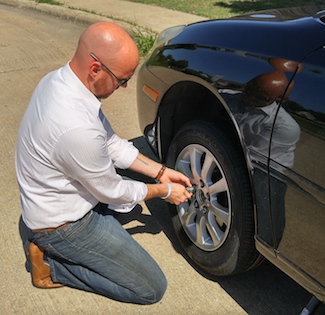
7. Lower the car by reversing direction on the jack
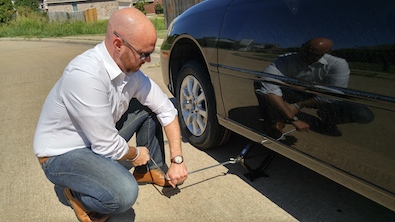 Seems pretty self-explanatory, right? The lug nuts/bolts are tight, right? Good. Grab the crank on the jack, turn it counter-clockwise, and bring the car back down. When the car is on the ground, continue to lower the jack to make sure it clears the side panel of the car, and then slide it out.
Seems pretty self-explanatory, right? The lug nuts/bolts are tight, right? Good. Grab the crank on the jack, turn it counter-clockwise, and bring the car back down. When the car is on the ground, continue to lower the jack to make sure it clears the side panel of the car, and then slide it out.
8. Tighten the lug nuts again
Now that the car is back on solid ground, apply the tire iron 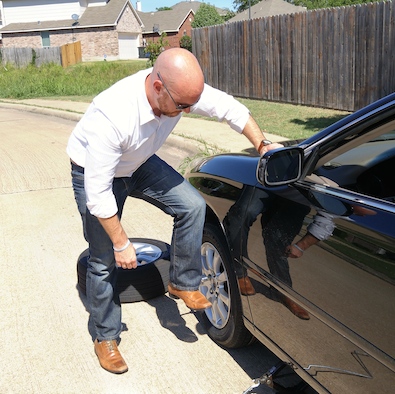 to the lugs and tighten them down again. In the absence of a torque wrench, I tighten them down with my foot (place foot on iron, press) about 1/4 to 1/2 turn past “hand tight.” Not much more. Tighter does not always equal safer. If you snap a bolt or wheel stud, you’re going to be so mad… and will need to get it repaired. Don’t be that guy.
to the lugs and tighten them down again. In the absence of a torque wrench, I tighten them down with my foot (place foot on iron, press) about 1/4 to 1/2 turn past “hand tight.” Not much more. Tighter does not always equal safer. If you snap a bolt or wheel stud, you’re going to be so mad… and will need to get it repaired. Don’t be that guy.
9. Put everything back in your trunk and drive away
Put the jack, iron, crank rod, and wheel lock (if applicable) back in your trunk. Then, place the flat tire in there as well. Get back in your car, drive to the nearest shop, and get your flat fixed. Sometimes it can be patched/plugged (around $30), and other times you’ll need a new tire. The shop will then replace your spare with the full-size tire and put your spare back in the trunk until next time. At this point, your very last step is to find a bar, order a cold one, and tell the tale of your adventure to any patron that will listen. Good job! You now know how to change a tire on a car.
BONUS Tips
- Keep wet naps and a rag in your trunk with the tools. This will help clean your hands after all that manly work.
- When you’ve got your wheel off, check your brakes. How much brake pad do you have left? Are your rotors scored like an old vinyl record? Less than 3mm of brake pad, and you need new brakes. If the rotors look like that old Prince album you have (don’t lie, we all know you do), they need to be replaced as well.
- When at the shop, understand that punctures in the sidewall of the tire make the tire un-patchable. The tire needs to be replaced. In most other cases, however, a plug will do the trick.
- When you’re pulling the tire off, check out the tread. Mine clearly shows abnormal wear on the outside of the tire. Some cars will show abnormal wear on the inside. Both cases indicate the need for an alignment. Even if the car doesn’t pull left or right, doesn’t mean the alignment isn’t burning the treads off your tires prematurely. Get an alignment and save yourself the trouble and cost of early tire replacement.
I was a mechanic for several years in Chicago, and have been working on cars as a hobby for what feels like my entire life. Sure, I may be a sharp dressed man, but I’m more than comfortable getting grease up to my elbows when working on a project car. There’s nothing quite like making something fast and loud.
Did these steps help you? Is there a piece of advice you’d like to add?
Leave a comment below so we can connect!




